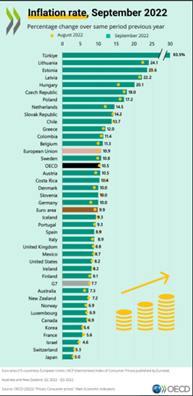Is inflation back for good? A seemingly simple question, but apparently much harder to answer by politicians and central bankers alike. While the Fed is nervously trying to tame the inflation monster by increasing the key interest rates, the European Central Bank (“ECB”) initially was quite reluctant to do so (as its main concern was rather the national governments’ debt levels) and the false believe that the inflation hike was just a temporary issue. At first, the ECB commented that inflation was only fired up due to the higher energy prices as a reaction to the war in Ukraine. Now that the predicted inflation peak every month keeps on shifting to the next month, inflation looks much more persistent than initially anticipated (by ECB) with the latest Belgian inflation rates as per September 2022 well above 10%. According to the data below provided by the OECD, other countries are faced with similar percentages:

Now that inflation is more persistent, the ECB reacted by rate increases in July, September, and November and promised even more action as long-term price growth expectations are now moving above its 2% target. This also has an impact on other interest rates.
An impact on the economy is to be expected soon. While in Belgium, which has a system of automatic wage indexation, purchasing power is more or less stabilized, while many companies will nevertheless face issues with passing on increased commodity prices to customers. Eventually, tougher economic times are looming.
Does inflation have an impact on your equity valuation? Although in theory inflation should not impact equity valuation, unfortunately that goes only in the long run, and even more unfortunate, in the long run we are all dead. Hence, in the short run, investors should be worried about inflation.
Considering the dividend discount model (“DDM”)1, inflation will not have an impact on equity valuation if the following conditions are met:
As it is reasonable to assume that inflation is not correctly anticipated at this moment, or at least will not be in the short run, it is obvious that inflation will have an impact on this valuation methodology. Additionally, market participants consistently make cognitive errors and do not adjust both the nominal required return and the nominal growth rate for changes in expected inflation. Investors make the error of discounting real cash flows using a nominal discount rate, which results in equities that are underpriced during periods of rapidly rising inflation. Indeed, inflation must be treated in a consistent manner in any discounted cash flow (“DCF”) model. Basically, there are 2 options:
Typically, the weighted average cost of capital (“WACC”), a typical discount rate applied in the DCF, is calculated at nominal rates and, thus, includes inflation. Therefore, in order to perform an equity valuation correctly, the forecasted cash flows should take into account inflation as well. Consequently, the manner of forecasting expected cash flows is important. The growth rate considered in these forecasts is typically applied on a company’s revenue that is calculated by using a currency’s current value. However, revenue growth can come either from actual expansion of the business in real terms or inflation.
Thus, if you are expecting to expand your business, in real terms, with 1% and you are able to pass on higher costs to customers resulting from inflation (taking into account the current inflation rate of approximately 9%), a growth of 10% should be considered in view of the Year 1 forecasts. However, if you consider to have issues passing on increasing costs resulting from inflation in the future, growth in real terms could be nullified by inflation.
In case you currently require an (equity) valuation, you should therefore take inflation into account. That’s why now is the time (to set things right).
To discuss the above reach out to the author.
Kenny Van Tulder - Senior Manager (kenny.vantulder@tiberghien.com)
1 The DDM is the simplest and oldest present value approach to valuating equity, in which the value of equity is calculated as the present value of the future dividends (i.e., the expected cash flow) to be received. It is most suitable when the company is paying dividends (i.e., the analyst has a dividend record to analyze), the company shows a clear dividend policy that bears an understandable and consistent relationship to its profitability, and the investor takes a non-control perspective.